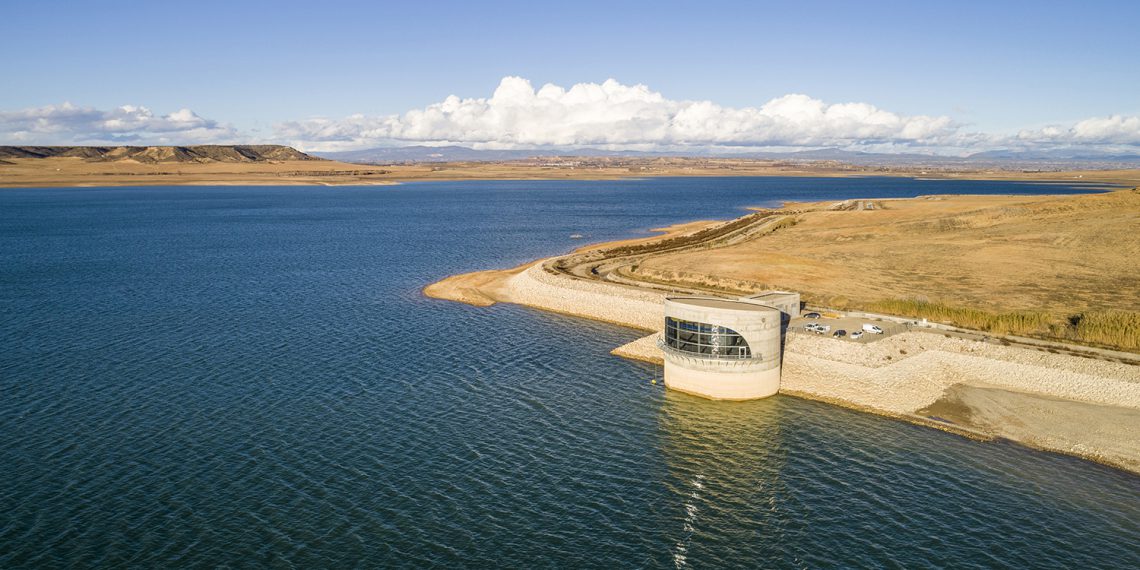During the dry summer season, the increase of the volume of water available to an irrigation channel in Northeast Spain has benefitted local agriculture. With extensive support from Sulzer, the reservoir of San Salvador has been successfully commissioned with energy consumption kept to a minimum.
Maintaining an effective agriculture system is essential to keeping food on the supermarket shelves and this requires an efficient and reliable supply of water. As the demand for this resource increases, so it becomes more important to optimize the storage and delivery of fresh water supplies.
 From the outset, the project owners were very clear that operational efficiency was the top priority to ensure that annual running costs were kept to a minimum. The company Sulzer design and engineering entered the competitive tender with a proposal that would later be shown to offer between 15% and 50% improvement, depending on the conditions, on the running costs of a rival bid. This benefit, while appealing, was supplemented by the proposal from Sulzer to work in partnership with the customer and offer its considerable expertise in pumping solutions.
From the outset, the project owners were very clear that operational efficiency was the top priority to ensure that annual running costs were kept to a minimum. The company Sulzer design and engineering entered the competitive tender with a proposal that would later be shown to offer between 15% and 50% improvement, depending on the conditions, on the running costs of a rival bid. This benefit, while appealing, was supplemented by the proposal from Sulzer to work in partnership with the customer and offer its considerable expertise in pumping solutions.
Rather than just delivering a number of pumps that could deliver the necessary water flows, Sulzer prepared a comprehensive solution that included all the control infrastructure as well as all the maintenance equipment. In fact, the design of the final installation would involve siphon-effect discharge pipework that would improve the performance of the pumps by reducing the static head. For this project, the company proposed some of its latest pumps equipped with premium efficiency, IE3, PE7 motors that would make an excellent starting point for an energy efficient installation.
 The customer was looking for a partner to help with the design of the pumping system as well as the infrastructure for removing and installing the pumps for maintenance. This needed careful consideration to ensure safe handling of the pumps. Additionally, all the lifting equipment and procedures had to be approved by an independent assessor.
The customer was looking for a partner to help with the design of the pumping system as well as the infrastructure for removing and installing the pumps for maintenance. This needed careful consideration to ensure safe handling of the pumps. Additionally, all the lifting equipment and procedures had to be approved by an independent assessor.
The circular shape of the pumping station building posed many challenges for the designers, not least the lack of space for all the equipment. Sulzer suggested the installation of one pump control center to operate two sets of pumps. This proposal was accepted, saving both space and expense for the project. The pumping station had to be built in two independently operated sections, allowing pump maintenance to be carried out without affecting capacity.
Each set of four pumps is made-up of two different pump models, chosen by the engineers to offer the most efficient pumping solution for every level of water in the reservoir. The pumps are controlled by variable speed drives and this combination allowed Sulzer to create a chart that showed how different combinations and settings of the pump control system would operate depending on the water levels in the reservoir.
 The pumping station is designed to maintain a sufficient water level in the distribution channel so that the irrigation system remains operational. However, the water levels in the reservoir can change substantially, especially between the dry and rainy seasons. Establishing the best pump arrangement and pumping regimes would pose a considerable challenge.
The pumping station is designed to maintain a sufficient water level in the distribution channel so that the irrigation system remains operational. However, the water levels in the reservoir can change substantially, especially between the dry and rainy seasons. Establishing the best pump arrangement and pumping regimes would pose a considerable challenge.
The pumps are installed over two levels as well as being split into two independent sections. Each pump was designed with its own siphon effect system at the discharge point that would deliver considerable energy savings over the whole service life of the pump. This was a very important consideration for the customer, and one that would be pivotal in Sulzer winning the contract.
In installations where large electric motors are operating round-the-clock, small improvements in efficiency can make a significant difference in energy costs. When this is combined with optimized valve designs, the addition of the siphon effect and precision control, the overall efficiency is magnified.
Biogas technologies for production of biomethane
The untapped feedstock potential for biomethane production in Spain is very large as the country has a very strong food...
Read more
















